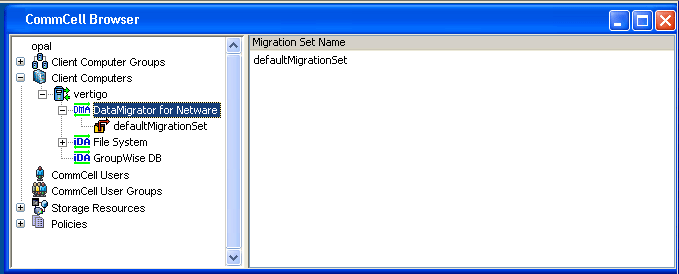
File Archiver for NetWare: Agents
| This feature/product/platform is deprecated in this release. See Deprecated Features, Products, and Platforms for more information. |
Choose from the following topics:
The File Archiver for NetWare Agent is a software module that is responsible for periodically moving unused or infrequently used NetWare File System data on a host computer to secondary storage, thereby reducing the size of data on the primary storage. File Archiver Agents reduce the duration of backup windows by reducing the amount of data to be backed up by an iDataAgent.
The File Archiver for NetWare Agent provides data protection support for all data types, except for those listed below.
The following file types/objects are not recommended for archiving. Although it is possible to archive them, doing so could cause applications or the operating system to not function properly.
The following file types/objects are automatically filtered out of migration archiving operations by the system, and cannot be archived.
When the File Archiver for NetWare Agent is installed, the following levels are automatically created in the CommCell Browser.
 |
|
| vertigo:Client File Archiver for NetWare: Agents |
defaultArchiveSet: Archive Sets |
| Before performing a Migration Archiving Operation using a File Archiver Agent, create a user-defined subclient. See Subclients - File Archiver for NetWare for more information. | |
To perform a data protection operation using this Agent a specific Product License must be available in the CommServe® Server.
Review general license requirements included in License Administration. Also, View All Licenses provides step-by-step instructions on how to view the license information.
Besides the CommServe and MediaAgent, there is one component to be installed for File Archiver for NetWare:
For the procedures on installing this component, refer to Deployment - File Archiver for NetWare Agent.
The migration archiving operation is based on subclients, so the following configuration is per subclient basis. The following options are located in the subclient Properties (Rules) tab.
The configuration of the archiving rules is central to customizing migration archiving operations to meet the needs of your organization. For more information, see Overview.
|
To keep the index within a manageable size, a new index will be created every certain number of migration operations. This value can be entered in the “Set index cycle to every n archive jobs” field on the subclient properties Rules tab.
After configuration is completed, the recovery administrator can schedule migration archiving jobs, similar to scheduling backup jobs for iDataAgents. To ensure that only successfully archived files will be changed into stubs, the migration archiving operation is divided into two phases: archiving and stubbing. The stubbing phase starts after the archiving phase succeeds. However, stubs will only be created if the subclient properties were configured to create them during archiving.
In the archiving phase, File Archiver for NetWare will archive the files meeting the pre-set archiving criteria and, if applicable, put them into a list for the stubbing phase and prune expired stubs.
Refer to Migration Archiving for more information on archiving.
File Archiver for NetWare provides three ways to recover an archived file:
From the CommCell Console, the browse of File Archiver for NetWare data is forced to be a non-image browse to view all the archived files in this archiving cycle (since last creation of new index). The recovery administrator can browse and find the file to recover. To find files archived earlier than the last creation of new index, the administrator can provide a point-in-time in the Browse Options dialog box.
The second method of recovery, is recovering archived files from stubs in Windows Explorer by double-clicking the stubs.
The third method of recovery can be accomplished from the NetWare system console by performing any action that causes an open and read on the archived files, such as the EDIT command.
Refer to Recover Archived Data for more information on Recovery operations.
The File Archiver for NetWare product does not provide the ability to restore the entire system in the event of a disaster. Systems using an Archiver Agent should also be protected using the corresponding backup and recovery agent. File Archiver for NetWare relies upon the NetWare File System iDataAgent to perform a full system restore of client data. For more information, see Restore Data - NetWare Server - Full System Restore.